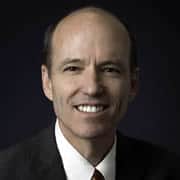
Why bank stocks underperform
Fred Cannon and Melissa Roberts of Keefe, Bruyette and Woods spend a lot of time dissecting the markets to understand financial stocks. Here, they give their views on how capital raises have affected the long-term performance of bank stocks, and which banks will do best when interest rates rise.
 Melissa Roberts is the senior vice president of quantitative research at Keefe, Bruyette & Woods. She leads a team of financial services research analysts. She holds a degree in Economics from Colgate University.
Melissa Roberts is the senior vice president of quantitative research at Keefe, Bruyette & Woods. She leads a team of financial services research analysts. She holds a degree in Economics from Colgate University.
 Fred Cannon is the director of research and chief equity strategist for Keefe, Bruyette and Woods. He has worked as Director of Investor Relations both for Golden State Bancorp and Bank of America. Fred holds a Master’s Degree from Cornell University and BS Degree from the University of California at Davis, both in agricultural economics.
Fred Cannon is the director of research and chief equity strategist for Keefe, Bruyette and Woods. He has worked as Director of Investor Relations both for Golden State Bancorp and Bank of America. Fred holds a Master’s Degree from Cornell University and BS Degree from the University of California at Davis, both in agricultural economics.
What might change the underperformance of banks going forward?
Fred: It’s very important to recognize that the banks have underperformed the broad market for the last couple of years not necessarily because they haven’t been able to generate earnings, but because they’ve diluted the share count so much because of the capital raising. It means stock prices just can’t recover to their pre-crisis levels. Citibank’s share count went from 5 billion shares to 30 billion shares.
How much equity are financial companies raising?
Melissa: For the entire market, they usually contribute roughly 40 percent to 50 percent in a non-crisis period. When we got to the height of the crisis in 2008, they contributed as much as 87 percent of the total additional capital that was being raised, and that was primarily due to the TARP issuances. In the first quarter of 2011, we found out financials were around 50 percent, but the bulk of that additional capital was really for real estate companies, not banks.
You do a lot of other research on financials. What surprising or interesting factors have you found influence bank stocks?
Melissa: If you look at a stock that has a large amount of short interest, it could sometimes be thought of as a future positive for the stock, because if you’re not saying that that stock’s going to go to zero, at some point, those shorts have to cover. The large-cap banks had a maximum short interest level on March 31, 2009, where 5.9 percent of tradable shares were owned by investors shorting the stock. Then they came down to a minimum on August 13th of 2010 of 2.6 percent. As the short interest levels were coming down in large-cap banks, those shorts were forced to cover the stock and that probably was a contributing factor to some of the outperformance of the large-cap banks. What’s also interesting here is that if you look at when the large-cap banks hit a minimum, it’s almost simultaneous with when the regional banks hit a maximum. It seems like investors are rotating their themes.
Fred: But I have to say some heavily shorted stocks did go to zero, so that theory doesn’t always work.
What will be the impact of rising interest rates on bank stocks?
Fred: What you’re really looking for is banks that have both very sticky deposits that won’t leave, even when rates go up, and variable rate loans that will adjust upward with higher interest rates. I think on our list some of the ones who’ll benefit the most include Silicon Valley Bank, The PrivateBank out of Chicago, and Comerica. We believe that the Fed is on hold for short-term interest rates until the second half of 2012. We think that until bank lending begins to grow, the Fed is going to be on hold. Ironically, the region of the country that has the slowest loan growth historically is now having the best, which is the Northeast. M&T Bank and then First Niagara, I think those are two good examples of banks who avoided much of the sins of the financial crisis, as their region did, and now are able to grow.
What are bank investors looking for now?
Fred: The bank stocks haven’t performed great in the first quarter, but 74 percent of the 79 bank stocks we track met or beat earnings in the first quarter. It’s not just about beating earnings; it’s also about showing that you can grow your revenue.
Forward looking statement: We believe that the Fed is on hold for short-term interest rates until the second half of 2012. We think that until bank lending begins to grow, the Fed is going to be on hold.


